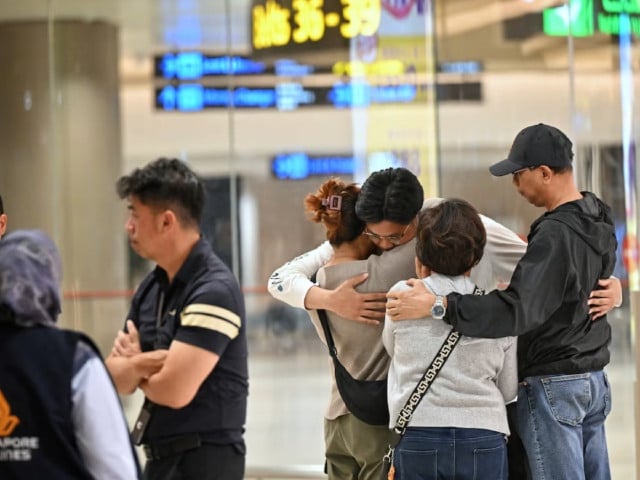After an emergency landing in Bangkok, over 140 passengers and crew members from a Singapore Airlines (SIAL.SI) flight that was severely disrupted, resulting in numerous injuries and one fatality, arrived in Singapore on a relief flight on Wednesday morning.
A Boeing (BA.N) 777-300ER airliner that was set to depart from London for Singapore was forced to divert to Bangkok due to turbulence. The turbulence threw the passengers and staff around the cabin, smashing some of them against the ceiling.
At least thirty individuals were hurt, and a 73-year-old British passenger passed away from what appeared to be a heart attack.
I witnessed passengers from the other side of the aisle flying straight up, striking the ceiling, and then landing back down in pretty strange postures. Dzafran Azmir, a 28-year-old student aboard the flight, told Reuters that some were suffering from concussions and severe brain injuries after arriving in Singapore.
Images taken inside the aircraft revealed oxygen masks and panels hanging from the ceiling, holes in the overhead cabin panels, and scattered luggage. According to a passenger, some people’s heads hit the lights above the chairs, shattering the panels.
The rescue flight from Bangkok carried 131 passengers and 12 staff members, arriving in Singapore just before 5 a.m. (2100 GMT). On the first flight, there were 211 passengers—many of them were Australians, British, or Singaporeans—and 18 crew members; the injured pilots and their families stayed in Bangkok.
In a video message, Singapore Airlines CEO Goh Choon Phong said, “On behalf of Singapore Airlines, I would like to express my deepest condolences to the family and loved ones of the deceased.”
According to a Facebook message from Singapore’s Transport Minister Chee Hong Tat, the country’s Transport Safety Investigation Bureau agents landed in Bangkok on Tuesday evening.
He added that the National Transportation Safety Board (NTSB) of the United States was sending an accredited person and four technical advisers to support the investigation because the event included Boeing, a U.S. corporation that manufactures the 777-300ER aircraft.
According to Goh, the pilot reported a medical emergency and decided to divert the aircraft to Bangkok after the aircraft experienced abrupt, severe turbulence.
According to flight monitoring data, the airplane encountered “a rapid change in vertical rate, consistent with a sudden turbulence event” around 07:49 GMT, according to aircraft tracking firm FlightRadar 24.
“There were severe thunderstorms in the area at the time,” it continued.
According to AccuWeather, a weather forecasting service, strong turbulence on Flight 321 was most likely caused by swiftly building, explosive thunderstorms near the flight path.
According to Dan DePodwin, Senior Director of Forecasting Operations at AccuWeather, developing thunderstorms frequently feature strong updrafts, which are zones of upward-moving air that rise quickly—sometimes at speeds of over 100 mph—and can leave pilots with little time to react if they happen directly in front of the aircraft.
About ten hours into the journey, over the Irrawaddy Basin in Myanmar, there was an abrupt turbulence, according to Singapore Airlines.
Large thunderstorms in the Bay of Bengal are relatively uncommon. Bumps are always possible, according to an airline pilot who frequently travels to Singapore and other parts of Southeast Asia.
Large thunderstorms in the Bay of Bengal are relatively uncommon. Bumps are always possible, according to an airline pilot who frequently travels to Singapore and other parts of Southeast Asia. The pilot declined to provide his name because he is not authorized to speak with the media.
“We were about 30 miles off track flying around the thunderstorms two days ago on the way to Singapore,” said the pilot.
Although there are several sources of turbulence, the most obvious one is the unpredictable weather patterns that lead to storms. However, clear air turbulence, which is harder to spot, may have also contributed to this flight’s disruption.
The Association of Flight Attendants—an organization representing over 50,000 workers at 20 airlines—said that Sara Nelson, its international president, stressed the importance of seatbelt use for all passengers.
“It truly is a matter of life and death,” Nelson declared.
An NTSB analysis from 2021 found that airplane accidents involving turbulent conditions are the most frequent kind of mishap.
Samitivej Hospital in Thailand reported that it was treating 71 passengers despite the airline’s claim that 30 people had been hurt.
The U.S. government discovered that between 2009 and 2018, turbulence was the cause of over 33% of reported airline accidents, with the majority leading to one or more significant injuries but no damage to the aircraft.
Major accidents have not occurred for Singapore Airlines in recent years, despite the airline being widely acknowledged as one of the best in the world and a model for most of the industry.
Its last fatal accident occurred on October 31, 2000, at Taiwan Taoyuan International Airport, during a trip from Singapore to Los Angeles via Taipei. Of the 179 passengers, 83 perished in the crash.
Due to a national holiday in Singapore on Wednesday, shares of Singapore Airlines were not traded.
I am a dedicated student currently in my seventh semester, pursuing a degree in International Relations. Alongside my academic pursuits, I am actively engaged in the professional field as a content writer at the Rangeinn website.







